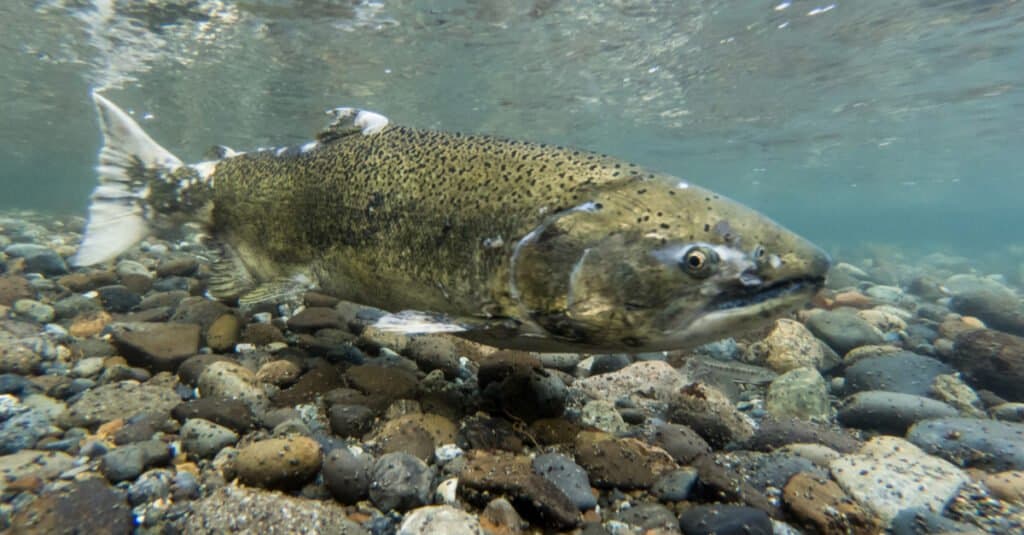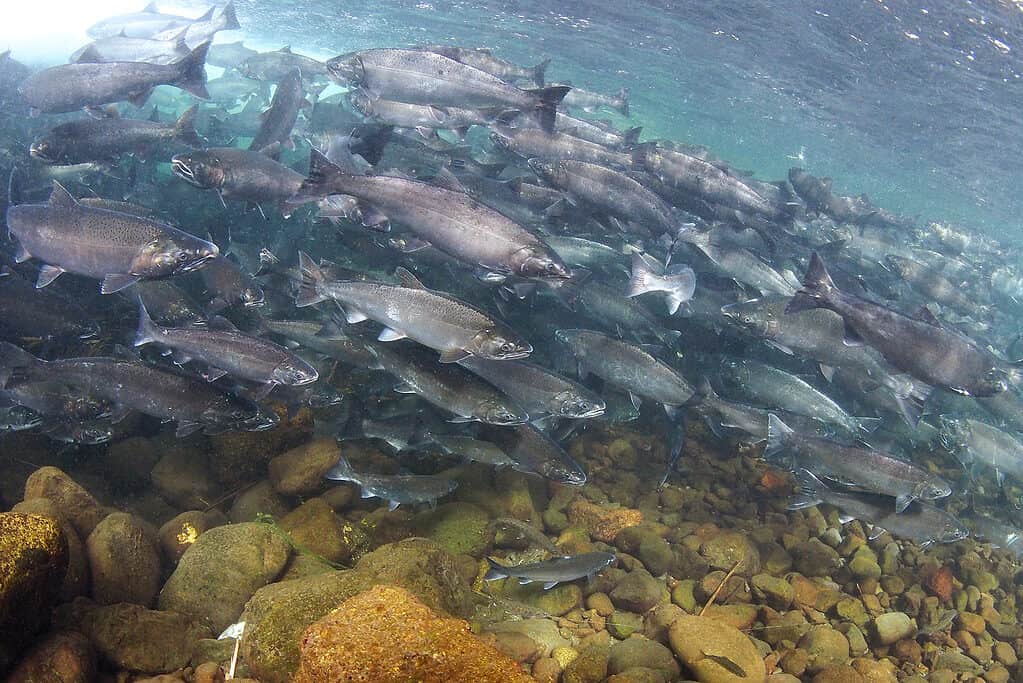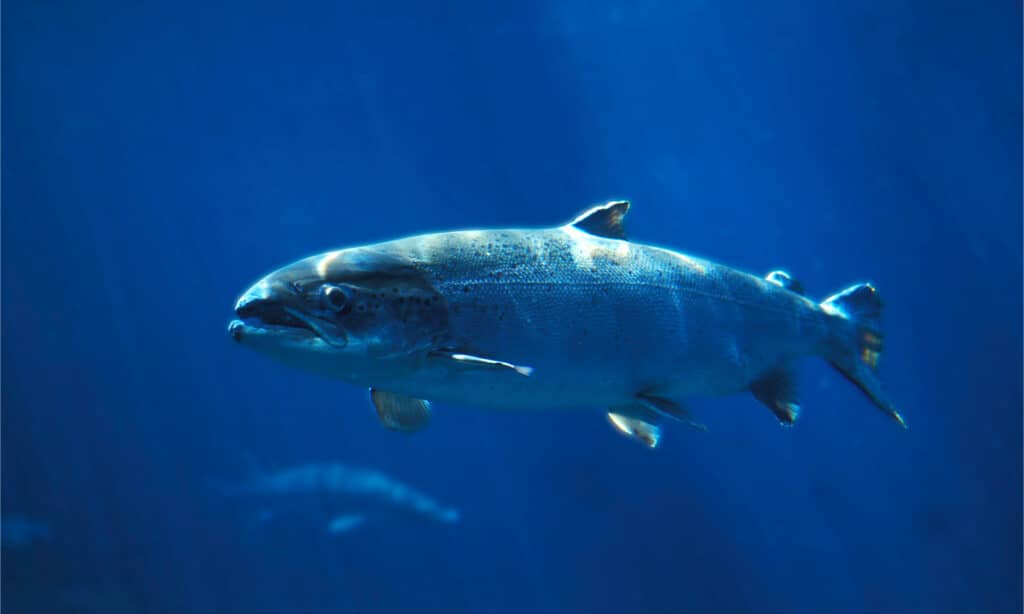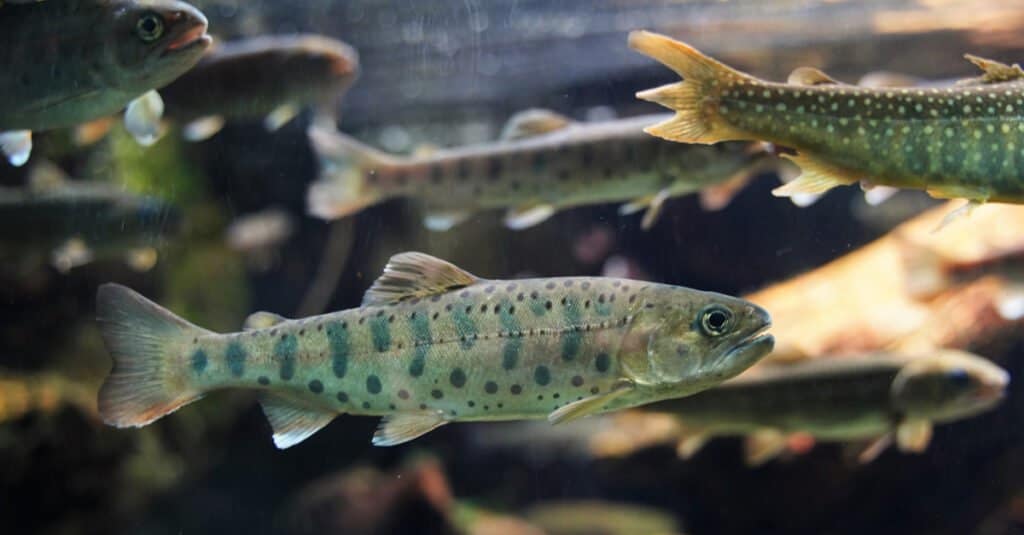Salmon is a popular and widely recognized fish species that can be found all over the world. Among the distinctive characteristics of different salmon species are varying sizes, ranging from small to large. It is fascinating to explore the different types of salmon and their sizes, especially considering the range in colors and the lifestyles of each species. In this article, we will delve into the different types of salmon and the sizes of each to provide a better understanding of these fascinating fish!
Salmon Size Comparison: Just How Big Do the Different Types Get?
Listed below are 8 different types of salmon, which are ranked according to their size (from largest to smallest):
1. Chinook Salmon

Chinook Salmon are the largest salmon species.
©Kevin Cass/Shutterstock.com
Chinook Salmon, also known as King Salmon, are a popular and highly prized species of salmon known for their large size and excellent flavor. Here is some information on Chinook salmon, including their size:
- Chinook Salmon are the largest salmon species, with mature adults typically ranging in size from 24 to 36 inches in length and weighing 10 to 50 pounds, although some individuals can grow even larger.
- Chinook Salmon are native to the Pacific Northwest region of North America and have a range that extends from California up to Alaska and into parts of Asia.
- Chinook Salmon has a distinctive appearance, with a bluish-green or blue-black back, silver sides, and a white belly. They also have black spots on their back and dorsal fin.
- Chinook Salmon are an anadromous species, which means they spawn in freshwater rivers and streams, but spend much of their adult life living and feeding in the ocean.
- Chinook Salmon are an important food source for a variety of predators, including bears, eagles, sea lions, and killer whales.
- Chinook Salmon populations have experienced significant declines over the past century due to habitat destruction, overfishing, and other factors, and are now considered to be a threatened species in some areas.
2. Coho Salmon

Coho salmon is a popular type of salmon found throughout North America.
©USFWS – Pacific Region / Flickr – License
Coho salmon, also known as silver salmon, is another popular species of salmon found in North America. They are known for their distinctive appearance and excellent flavor. Here are some details about them, including their size:
- Coho salmon are typically smaller than Chinook salmon but are still considered medium to large-sized species. Adults typically range from 24 to 30 inches in length and weigh 8 to 12 pounds, although some individuals can grow as large as 36 inches and weigh up to 31 pounds.
- Coho salmon can be found from California to Alaska on the Pacific Coast, as well as in some areas of the Great Lakes region.
- Coho salmon have a distinctive appearance, with a metallic silver body and black spots on their back, dorsal fin, and tail. They also have a dark blue-green coloration on their backs and a white belly. Once spawning season arrives, its head turns red, and its teeth become more prominent.
- Like Chinook salmon, Coho salmon is an anadromous species and spend much of their adult life living and feeding in the ocean before returning to freshwater rivers and streams to spawn.
- Coho salmon populations have also been impacted by habitat destruction, overfishing, and other factors and conservation efforts are underway to protect and restore their populations.
3. Sockeye Salmon

Sockeye salmon is a medium-sized salmon species.
©Vasik Olga/Shutterstock.com
The sockeye salmon is a medium-sized salmon species that is known for its distinctive red flesh. While not as large as Chinook salmon, sockeye salmon can still grow to be a decent size. Here are some details on Sockeye salmon, including how big it gets:
- Sockeye salmon are medium-sized compared to other salmon species, typically ranging from 18 to 31 inches in length and weighing 4 to 15 pounds.
- Sockeye salmon, also known as red salmon, is a species of salmon found in the North Pacific Ocean and the rivers and streams that feed into it.
- The sockeye salmon has a bright red body with a blue-green head. They also have the unique ability to transform the color of their bodies to camouflage and survive in both fresh and saltwater environments.
- Sockeye salmon are known for their distinctive red flesh, which is the result of their diet which includes krill and shrimp.
- Sockeye salmon are an important food source for many animals, including humans, bears, eagles, and orcas.
- Sockeye salmon are anadromous, spending the first part of their lives in freshwater before migrating to the ocean to grow and mature. They return to their natal streams and rivers to spawn.
- Some populations of Sockeye salmon are considered endangered or threatened due to overfishing, habitat destruction, and other factors. Conservation efforts are underway to protect and restore these populations.
4. Chum Salmon

Chum salmon are also known as “dog” salmon because of their teeth.
©The Old Major/Shutterstock.com
Chum salmon, also known as dog salmon, is a species of salmon found in the Pacific Ocean and river systems around the Pacific Rim. Here are some details on the chum salmon, including its size:
- Chum salmon tend to be on the smaller side compared to other salmon species, typically ranging from 18 to 24 inches in length and weighing 8 to 20 pounds, though some individuals can grow larger.
- Chum salmon are known for their distinctive species-specific coloration, which varies depending on the region, but usually includes a dark back with silver sides and purple vertical stripes. They also have large canine-like teeth, hence the nickname “dog salmon.”
- Chum salmon are an important food source for many animals, including humans, bears, eagles, and orcas.
- Chum salmon are anadromous, meaning they hatch in freshwater rivers or streams, migrate to the ocean to feed and grow, and then return to their natal streams and rivers to spawn.
- Chum salmon are not as highly prized for their culinary qualities as other salmon species but are still commonly used in canned salmon products and as a source of roe.
- Chum salmon, like sockeye, have the unique ability to transform the color of their bodies to camouflage and survive in both fresh and saltwater environments.
5. Atlantic Salmon

Atlantic salmon are fusiform, which means that they have a spindle-like shape.
©slowmotiongli/Shutterstock.com
Atlantic salmon is a species of salmon found in the northern Atlantic Ocean and rivers and streams that feed into it. Here are some additional details on Atlantic salmon, including its size:
- In the wild, adult Atlantic salmon can range in size from 24 to 30 inches and weigh between 8 and 12 pounds, although individuals have been known to exceed 35 pounds. Farmed salmon can be larger due to controlled feeding and growth conditions, however, there are concerns about their impact on the environment and wild salmon populations.
- Atlantic salmon is a species of salmon that is culturally and ecologically significant, but it has been declining in recent years. This has led to it being listed as a protected species by NOAA Fisheries in the United States.
- Atlantic salmon are fusiform, which means that they have a spindle-like shape.
- All Atlantic salmon in the public market is cultured and commercially grown, according to NOAA Fisheries.
- Typically, an Atlantic salmon returning to U.S. waters will be 4 years old, according to NOAA. However, the size can vary depending on whether it is wild or farmed salmon.
- Atlantic salmon are anadromous, meaning they hatch in freshwater streams, migrate to the ocean to feed and grow, and then return to their natal streams and rivers to spawn.
6. Pink Salmon

Migration of pink salmon. These salmon typically range from 3 to 5 pounds.
©COULANGES/Shutterstock.com
Pink salmon is a relatively small species of Pacific salmon and is also the most abundant species of Pacific salmon. Here is some more information regarding pink salmon, including size:
- Pink salmon is a species of Pacific salmon found in North American waters and the northern Pacific Ocean. It is also called “Humpies” due to the humped back that males develop during spawning.
- Pink salmon are the smallest of the Pacific salmon species, typically weighing 3 to 5 pounds and measuring 20 to 25 inches in length.
- Pink salmon is the most abundant species of Pacific salmon and supports a significant commercial and recreational fishery.
- Pink salmon have a two-year lifecycle, meaning they hatch in freshwater streams, migrate to the ocean to feed and grow for around 18 months, and then return to their natal streams to spawn before dying. This is the shortest lifespan of all Pacific salmon species.
- Pink salmon can be distinguished from other Pacific salmon by their small size, humped back, and large dark oval spots on their back and tail.
- Wild-caught Pink salmon is considered a smart seafood choice by NOAA Fisheries due to its sustainability status.
7. Masu Salmon

Masu Salmon are only found in Japan and Russia.
©dokosola/Shutterstock.com
Masu salmon is a smaller species of Pacific salmon found in Japan and eastern Russia. Let’s explore more about this salmon, starting with its size:
- Masu salmon is one of the smaller Pacific salmon species, typically ranging from 12 to 24 inches in length and weighing 1 to 8 pounds.
- Masu salmon is also known as cherry salmon or Japanese chum salmon.
- Masu salmon are important culturally and economically in Japan, where they are considered a delicacy and are farmed commercially.
- Masu salmon have distinctive small black spots on their back and red-orange flesh.
- Masu salmon has a two-year lifecycle, similar to pink salmon, meaning they hatch in freshwater streams, migrate to the ocean to feed and grow, and then return to their natal streams to spawn before dying.
8. Amago Salmon

The Amago salmon is classified as a sub-species of the Masu Salmon.
©Photographer_Cage/Shutterstock.com
The Amago salmon, also known as the red-spotted masu salmon, is a subspecies of masu salmon found in Japan. How big does it get? Find this out below, plus more interesting facts!
- Amago salmon is typically smaller than other Pacific salmon species, with adults ranging from 12 to 18 inches in length and weighing up to 4 pounds.
- Like other Pacific salmon species, Amago salmon have a two-year lifecycle, migrating to the ocean to feed and grow and returning to their natal streams to spawn before dying.
- Amago salmon is an important game fish in Japan and is highly prized for its delicate flavor and beautiful appearance.
- Amago salmon has red spots on their body that get more pronounced during the spawning season.
In Conclusion
After researching the different types of salmon, it is clear that there is a great deal of diversity among these fish. While their size varies greatly, with Amago salmon being the smallest and Chinook salmon being the largest, each species also displays unique habitat preferences, physical characteristics, and lifecycles. It is fascinating to learn about these distinct differences and how each salmon species has adapted and evolved based on their unique environmental preferences. Overall, the world of salmon is truly diverse and complex, adding to the charm and intrigue of these much-loved fish.
The photo featured at the top of this post is © iStock.com/John Pennell
Thank you for reading! Have some feedback for us? Contact the AZ Animals editorial team.






